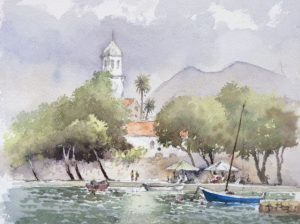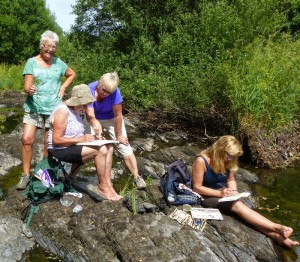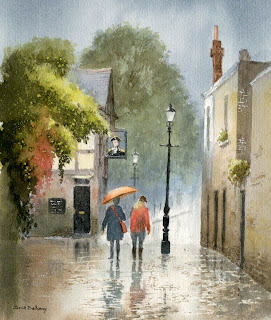I have a great affection for rural lanes, especially old rutted cart-tracks. While they are superb for leading you into a composition they are also excellent subjects in their own right. When I plan a sketching trip I often seek out winding lanes on the walking map, and where they lead to an interesting-looking subject such as a mountain or hill, then there is a strong chance of a good subject.
This particular lane heads towards the Brecon Beacons and I tramped it on a sunny winter day. I particularly liked the way the low sunlight cast shadows across the lane, and was keen to include this aspect, as well as giving the feature a few extra ruts for good measure. Ruts, puddles, clumps of grass and weeds and stones can be exaggerated or even added if they are not present, to give the composition more character. Keep a file of drawings, sketches and photographs of these countryside features so that you can add them in when needed. Undulating hedgerows with gaps here and there enhance the rustic nature of the place as do mature trees and bushes, and if you’re feeling really bold why not include a rustic shepherd wending his weary way home?
The painting was done on a sheet of quarter-imperial Saunders Waterford rough paper, a beautiful surface to work on, and the rough surface enhanced the track, especially where I used drybrush strokes.
It’s been all-action since my last blog, from the marvellous annual festival at Patchings Art Festival in Nottingham’s Robin Hood country where I demonstrated the Saunders Waterford papers for St Cuthberts Mill, and had the pleasure of meeting a lot of you. I’ve also just returned from an immensely rewarding trip to Germany, so that has a lot of potential for some great artwork.
I do hope, like me, you’ve enjoyed this amazing summer and made full use of it with your paintbrush!



 If you keep an eye on the weather forecast you might get some idea of what’s to come, but they seem to get it so wrong so often that it pays to be prepared for those glorious days when conditions are just right, whether snow is on the ground or not. If it takes you an hour or more to get your art gear together then you may well have lost the best part of the day, so having all your kit ready for action is vital. As far as keeping warm and dry is concerned, you can see in the photo that I am wrapped up in a warm fleece jacket, a warm sheepskin hat, scarf and thin gloves in which I can sketch quite happily. My trousers are lined, I have woollen socks and boots, thermal vest and inside the rucsack is my waterproof outer gear, a long neck tube which can cover not just my neck but up over my head as well, if need be, a steel thermos flask, mug, etc, so that I can make soup, coffee, tea, cappuccinos, the lot. I’m there to enjoy myself, so why not?
If you keep an eye on the weather forecast you might get some idea of what’s to come, but they seem to get it so wrong so often that it pays to be prepared for those glorious days when conditions are just right, whether snow is on the ground or not. If it takes you an hour or more to get your art gear together then you may well have lost the best part of the day, so having all your kit ready for action is vital. As far as keeping warm and dry is concerned, you can see in the photo that I am wrapped up in a warm fleece jacket, a warm sheepskin hat, scarf and thin gloves in which I can sketch quite happily. My trousers are lined, I have woollen socks and boots, thermal vest and inside the rucsack is my waterproof outer gear, a long neck tube which can cover not just my neck but up over my head as well, if need be, a steel thermos flask, mug, etc, so that I can make soup, coffee, tea, cappuccinos, the lot. I’m there to enjoy myself, so why not?
 The sun beat down every day on our recent landscape course at Builth Wells, although happily we did have some welcome fluffy white clouds at times for variation. The ideal spot was down by the river running through the hotel grounds, where several students took the opportunity to dangle their feet in the water while they sketched. In the photo Jenny is giving advice as they paint a mixture of delightful cascades and still water punctuated with stunning colour reflections. Make the most of this lovely sketching weather.
The sun beat down every day on our recent landscape course at Builth Wells, although happily we did have some welcome fluffy white clouds at times for variation. The ideal spot was down by the river running through the hotel grounds, where several students took the opportunity to dangle their feet in the water while they sketched. In the photo Jenny is giving advice as they paint a mixture of delightful cascades and still water punctuated with stunning colour reflections. Make the most of this lovely sketching weather.